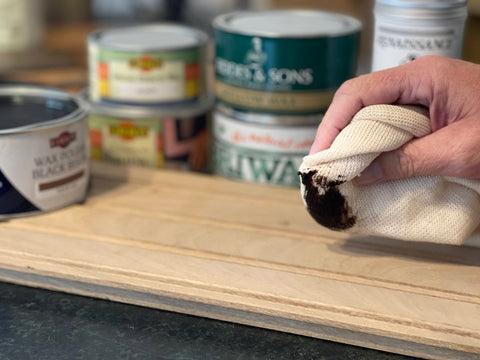New: Restorate Digital Gift Vouchers
The perfect gift for the Restorator in your life. Available to use in a matter of minutes.

New: Restorate Digital Gift Vouchers
The perfect gift for the Restorator in your life. Available to use in a matter of minutes.

Mike Yiend |
There are so many different ones out there - how do I know which one is best for my job?
Let’s go through them and it will hopefully then make sense! First of all, an explanation of a term that will be repeated throughout this piece: Sealed Wood
Sealed wood refers to a surface that has either been waxed previously or has been treated with a sanding sealer.
The porosity of wood can vary across it’s surface so the application of a sanding sealer to sanded bare wood will provide a consistent base for waxing and avoid the possibility of blotchiness. It will make the surface more durable and give a better sheen.
A long time favourite with furniture and cabinet makers, Briwax Original can be used on bare or sealed wood. It’s available either as a clear wax or in a variety of colours. It contains a solvent called Toluene, which makes the wax easier to apply and to buff up. It’s quite strong, so ventilate well when using Briwax and use suitable protective gloves.
Supreme wax contains an environmentally friendly blend of waxes and can be used on both bare or sealed wood. It is virtually odour free, making it a good choice for use in the home, and is available in clear or coloured versions.
A blend of Beeswax and Carnauba Wax, Mellow Wax is for use on sealed or previously waxed wood. It’s available as a clear wax or four coloured options.
HARRELLS TRADITIONAL WAX POLISH:
A blend of Beeswax and other natural waxes, Harrells has been produced to the same recipe for 90 years by London manufacturer W S Jenkins. It has long been a favourite of antique dealers and furniture restorers and is particularly suitable for applying to sealed wood. It’s available in clear plus 5 coloured options.
LIBERON BLACK BISON PASTE WAX:
Usable on bare or sealed wood, this wax is popular for household use due to it’s pleasant fragrance. It is also safe for use on toys and is available in a wide range of colours plus clear and neutral.
Clear waxes will impart warmth to the surface but the neutral wax will not do this.
Don’t worry when the tin arrives with a hole punched in the middle! It hasn’t had an accident - the wax is poured hot at the factory and needs to ventilate as it cools. The hole is necessary to prevent a vacuum forming.
Liberon also offer a liquid wax, which would be the ideal choice if treating a large area. It is also the best thing to use on rougher surfaces, such as beams.

LIBERON SPECIAL EFFECTS WAXES:
Liberon offer two waxes used to give an aged appearance on a variety of surfaces. Verdigris Wax will produce the green hues of oxidised copper or brass and can be used on wood, metal or plaster.
Black Patinating Wax is used to age modern furniture or to disguise repairs. It is suitable for use on wood, metal, gilt, plaster, MDF and papier mache.
This is used to create a white limed effect on softwoods and hard woods. It is worked into the grain and then the remaining ‘haze’ is removed with a cloth. It can then be given a protective coat of neutral wax or finishing oil.
Renaissance Wax is an extremely versatile product that is widely used in museums and art galleries for the conservation of antiquities. It is pH neutral and can therefore can be used on a wide array of surfaces and leaves a hard glass-clear finish on anything from metal to photographs, protecting the surface from contamination by handling or environmental factors.
Unusually for a wax, it can also be used outside to protect things like sculptures and vintage vehicles.
BRIWAX NATURAL CREAMED BEESWAX:
This can be used to clean wood and revive it’s natural colour. A typical use would be in the restoration and protection of antique furniture as it will enrich the patina acquired over time. It is best used on sealed wood.

1 comment
What a terrific article. Thank you.